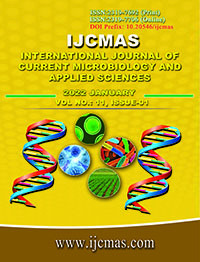


 National Academy of Agricultural Sciences (NAAS)
National Academy of Agricultural Sciences (NAAS)

|
PRINT ISSN : 2319-7692
Online ISSN : 2319-7706 Issues : 12 per year Publisher : Excellent Publishers Email : editorijcmas@gmail.com / submit@ijcmas.com Editor-in-chief: Dr.M.Prakash Index Copernicus ICV 2018: 95.39 NAAS RATING 2020: 5.38 |
A field experiment was conducted during Rabi seasons (2016-17 to 2020-21) at research farm of R.K. (P.G.) College, Shamli, with three replications under split-split plot design. FYM levels were taken as main plot, three N levels as sub plot and four biofertilizer treatments as sub-sub plot. Application of 10 ton FYM/ ha resulted significant decrease in bulk density from 1.23Mg/ M3 to 1.18 Mg/ M3. Joint inoculation with Azotobactor + Azospirillum resulted, 9.6, 25 and 11.02 percent higher WHC, organic carbon and available N in soil, respectively over no inoculation. The plots receiving 10 ton FYM/ ha maintained 24.76, 54.61 and 67.56 percent higher grain yield per spike, biological and grain yield/ ha, respectively over 0 ton FYM. Application of 120 kg N/ ha had 22.64, 31.83 and 31.46 percent higher grain yield/ spike, biomass and grain yield/ ha, respectively over 40 kg N. Highest protein (13.25%) was registered with 10 ton/ ha FYM. Azotobactor + Azospirillum had 7.06 percent higher protein over uninoculated control. Highest gross (₹ 112091/ ha), net return (₹ 76343/ ha) and benefit: cost ratio (2.14) observed with 120 kg N/ ha. Azotobactor + Azospirillum resulted, 34.85 percent higher net return over no inoculation.
 |
 |
 |
 |
 |